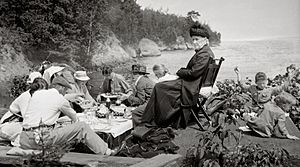Basswood Island facts for kids
Basswood Island is a beautiful island located in Lake Superior, off the coast of Wisconsin. It's one of the many islands that make up the famous Apostle Islands, which are protected as part of the Apostle Islands National Lakeshore. This special island has a rich history, once home to a busy farm and a quarry that provided valuable stone for buildings.
Contents
Discovering Basswood Island
Basswood Island is a part of the amazing Apostle Islands National Lakeshore. This means it's a special place where nature and history come together. Visitors can explore its shores and imagine what life was like long ago. The island offers a glimpse into Wisconsin's past.
A Look at the Past
From 1865 to 1923, Basswood Island was home to a working farm. Richard McCloud and Elisha Brigham ran this farm. They lived and worked on the island for many years. Their farm was an important part of the island's history. It shows how people used to live off the land in this area.
The Famous Brownstone Quarry
Basswood Island was also the site of a very important quarry. A quarry is a place where stone is dug out of the ground. The Bass Island Brownstone Company operated this quarry from 1868 into the 1890s. They dug out a type of stone called brownstone.
What is Brownstone?
Brownstone is a reddish-brown sandstone. It was very popular for building houses and other structures. People loved its unique color and strength. Brownstone from Basswood Island and other Apostle Islands quarries was in high demand. It was used in many important buildings.
Brownstone in Milwaukee
One famous example is the first Milwaukee County Courthouse. This important building was constructed in the 1860s. It used brownstone from Basswood Island. This shows how valuable the stone from this island was. It helped build parts of Wisconsin's history.
A Historic Site
The quarry on Basswood Island is so important that it's listed on the National Register of Historic Places. This means it's recognized as a significant historical site. It helps us remember the hard work and industry of the past. It also reminds us of the natural resources that shaped the region.
Images for kids





